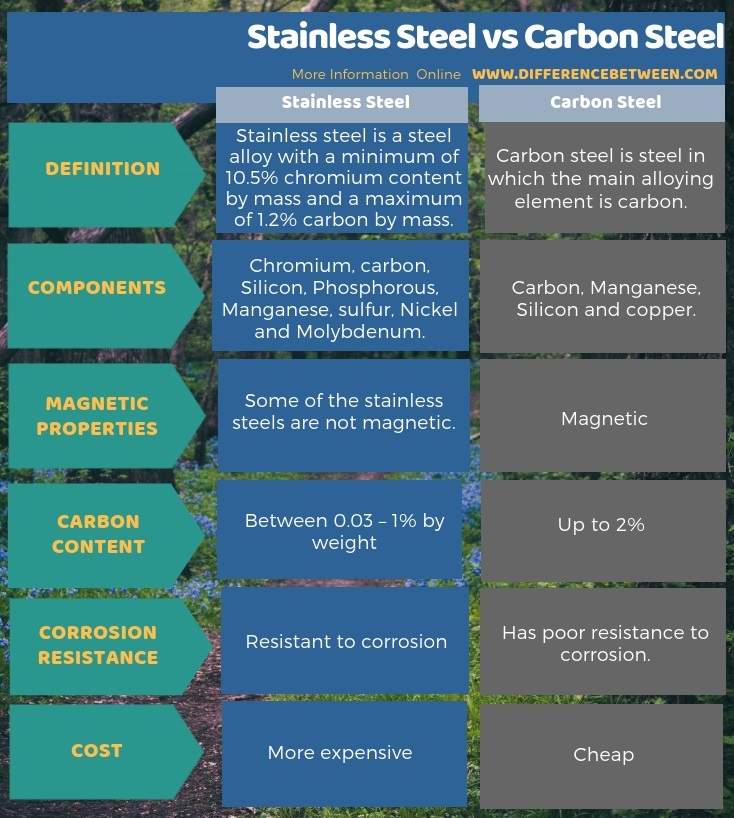Difference Between Stainless Steel and Carbon Steel
The key difference between stainless steel and carbon steel is that the main alloying element in carbon steel is carbon while it is chromium in stainless steel.
Stainless steel and carbon steel are iron alloys, which fall under the category of steel. Steels contain carbon up to 2% by weight. We can differentiate stainless steel and carbon steel according to their alloying elements and their compositions.
CONTENTS
1. Overview and Key Difference
2. What is Stainless Steel
3. What is Carbon Steel
4. Side by Side Comparison – Stainless Steel vs Carbon Steel in Tabular Form
5. Summary
What is Stainless Steel?
As the name implies, stainless steel is resistant to corrosion, unlike other steels. In this form of steel, the chromium percentage is at least 10.5% by weight. The corrosion resistance of stainless steel is due to the high amount of chromium present in this steel. There, chromium forms an invisible, thin and adherent oxide layer, which makes the surface passive. In order to form this passive oxide layer, steel should contain enough chromium, and we need to keep it in an oxygen-rich environment. The passive layer protects the metal beneath, by covering it from air and water. Also, if we scratch the oxide layer, it heals itself. Because of this, the chromium percentage of stainless steel should exceed more than 10.5% by weight.

Figure 01: Stainless Steel Products
Other than chromium and carbon, stainless steel contains silicon, phosphorous, manganese, sulfur, nickel and molybdenum. Typically, stainless steel contains carbon in the range of 0.03 – 1% by weight. If the carbon content increases to more than that, it may reduce the stainless property of this steel by making Cr23C6, and lessening Chromium make the passive oxide layer. Further, we can classify stainless steels as Austenitic, Ferritic, Martensitic, Precipitation-Hardening, Duplex and Cast according to their crystalline structure. Due to some of the alloying elements, stainless steel can become non-magnetic.
What is Carbon Steel?
Other than the stainless steel, all the other steels are carbon steels. Carbon steel contains up to 2% carbon, up to 1.65% manganese, up to 0.6% silicon and up to 0.6% copper by weight. Depending on the carbon content, we can classify this type of steel further into low carbon steel, medium carbon steel, and high carbon steel. Moreover, this alloy is less corrosion resistant than stainless steel. Because of this, we should not use it in corrosive atmospheres or else we need to coat them with a protective layer.
Apart from that, carbon steels are cheaper than stainless steels as its main alloying element is carbon, while the relatively expensive chromium is stainless steels’ main alloying element. This steel form becomes stronger and harder with the increasing content of carbon, but it lessens the ductility. We can change the required mechanical properties of this steel from heat treating.

Figure 02: Carbon Steel Bars
Stainless steel and carbon steel are useful for many applications like skyscrapers, bridges, aviation industry, mining, offshore industry, pipes etc. Both are ductile materials, and we use them sometimes for decorative purposes. Depending on the alloying elements and their composition, their properties vary readily. Therefore, stainless steel or carbon steel must be selected as to the requirement of the application.
What is the Difference Between Stainless Steel and Carbon Steel?
Stainless steel is a steel alloy with a minimum of 10.5% chromium content by mass and a maximum of 1.2% carbon by mass and carbon steel is steel in which the main alloying element is carbon. The key difference between stainless steel and carbon steel is that the main alloying element in carbon steel is carbon while it is chromium in stainless steel. Also, a further difference between stainless steel and carbon steel is that the major components of stainless steel are chromium, carbon, silicon, phosphorous, manganese, sulfur, nickel and molybdenum while that of carbon steel are carbon, manganese, silicon and copper.
The below infographic on the difference between stainless steel and carbon steel shows more information on these differences.

Summary – Stainless Steel vs Carbon Steel
Stainless steel and carbon steel are two forms of alloys. The key difference between stainless steel and carbon steel is that the main alloying element in carbon steel is carbon while it is chromium in stainless steel.
Reference:
1. Steven E. Hughes, in A Quick Guide to Welding and Weld Inspection, 2009
2. P. Zarras, J.D. Stenger-Smith, in Handbook of Smart Coatings for Materials Protection, 2014
Image Courtesy:
1.”3354238″ by MartinaMang (CC0) via pixabay
2.”Stainless Steel Carbon Steel Mild Steel Duplex Steel nickel Alloys Titanium CuproNickel Round Bar” By Jatinsanghvi – Own work, (CC BY-SA 3.0) via Commons Wikimedia
ncG1vNJzZmivp6x7pbXFn5yrnZ6YsqOx07CcnqZemLyue8OinZ%2Bdopq7pLGMm5ytr5Wau26%2F05qgp6SVqMBuv9OenKVlkaOxbsLSZpqaqpKku26%2F056cpWc%3D